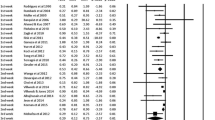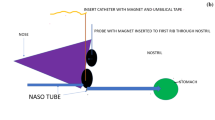Abstract
Twenty-two infants with high-risk esophageal atresia treated in Nigeria have been studied with the aim of determining: (1) when to carry out repair of the oesophagus; (2) whether it is better to carry out multiple or one-stage (primary) repairs; and (3) which thoracotomy approach is associated with a better chance of survival in these sick infants. The 7 survivors in the series were among the 12 infants who had early esophageal repair immediately following 24–48 h of medical treatment of their pneumonia. None of the 10 others in whom medical treatment was prolonged beyond 48 h or who had a staged procedure survived. There was no significant difference in the mortality of the 7 infants who had extrapleural thoracotomy from that of the 6 who had a transpleural approach (P<0.5). Pulmonary infection due to delayed diagnosis and administration of feedings was the commonest cause of death. Measures directed at early diagnosis in the newborn nursery before th baby is fed should drastically reduce the high mortality.
Similar content being viewed by others
References
Ein SH, Theman E (1973) A comparison of the results of primary repair of esophageal atresia with tracheoesophageal fistulas using end-to-side and end-to-end anastomosis. J Pediatr Surg 8: 641–645
Gandhe ML (1982) Congenital esophageal atresia: a review of clinical experience of 47 cases. In: Rickham PP, Hecker WCh, Prevot J (eds) Pediatric surgery in tropical countries. Progress in pediatric surgery, Vol 15, Urban and Schwarzenberg, München Wien Baltimore, pp 237–242
Gough MH (1980) Esophageal atresia: use of anterior flap in the diffecult anastomosis. J Pediatr Surg 15: 310–311
Grosfeld JL, Ballantine TVN (1978) Esophageal atresia and tracheoesophageal fistula: effect of delayed thoracotomy on survival. Surgery 84: 394–402
Holder TM, Cloud DT, Lewis Jr JE, Pilling GP (1964) Esophageal atresia and tracheoesophageal fistula. A survey of its members by the surgical section of the American Academy of Pediatrics. Pediatrics 34: 542–549
Kadowaki H, Nakahira M, Umeda K, Yamada C, Takenchi S, Tamate S (1982) A method of delayed esophageal anastomosis for high risk congenital oesophageal atresia with additional intra-abdominal anomalies; transgastric ballon “fistulectomy”. J Pediatr Surg 17: 230–233
Louhimo I, Lindahl H (1983) Esophageal atresia: primary results of 500 consecutively treated patients. J Pediatr Surg 18: 217–229
Louhimo I, Salamaa M, Suutarinen T (1970), Post-operative intensive care of esophageal patients. J Pediatr Surg 5: 633–640
Myers NA (1974) Oesophageal atresia: the epitome of modern surgery. Ann R Coll Surg Eng 54: 277–287
Pietsch JB, Stokes KB, Beardmore HE (1978) Esophageal atresia with tracheoesophageal fistula: end-to-end versus end-to-side repair. J Pediatr Surg 13: 677–681
Puri P, Blake N, O'Donnel B, Guiney EJ (1981) Delayed primary anastomosis following spontaneous growth of oesophageal segments in esophageal atresia. J Pediatr Surg 16: 180–183
Schullinger JN, Vinocur CD, Santulli TV (1982) The suture fistula technique in repair of selected cases of esophageal atresia. J Pediatr Surg 17: 234–236
Touloukian RJ (1981) Long term results following repair of esophageal atresia by end-side anastomosis and ligation of tracheoesophageal fistula. J Pediatr Surg 16: 983–988
Tyson KRT (1976) Primary repair of esophageal atresia without staging or preliminary gastrostomy. Ann Thorac Surg 21: 378–381
Vizas D, Ein SH, Simpson JS (1978) The value of circular myotomy for esophageal atresia. J Pediatr Surg 13: 357–359
Waterston DJ, Carter REB, Aberdeen E (1962) Oesophageal atresia: tracheoesophageal fistula. A study of survival in 218 infants. Lancet I: 819–822
Author information
Authors and Affiliations
Rights and permissions
About this article
Cite this article
Debo Adeyemi, S. Management of Nigerian neonates with high-risk esophageal atresia: early versus delayed repair. Pediatr Surg Int 4, 76–79 (1989). https://doi.org/10.1007/BF00181837
Issue Date:
DOI: https://doi.org/10.1007/BF00181837




